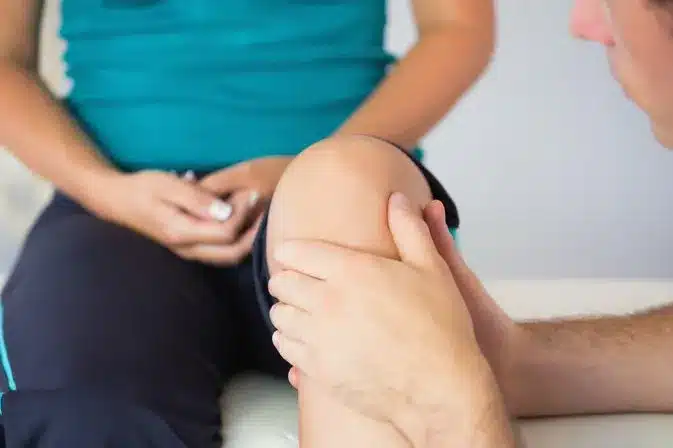When you need to have total knee replacement, the recovery period tends to lie heavily on your mind. It’s a critical part of getting you back on your feet and into your normal lifestyle again, as without it you will not heal properly. Whatever the reason you’ve had the surgery for, you can, at the very least, know what to expect from the recovery. Below we’ve put together a little timeline for the twelve weeks of rehabilitation, so that you can know what your goals are for your healing.
The Beginning:
Rehabilitation for knee replacement, unlike in some other surgeries, begins pretty much from the moment you wake up from surgery. Within the first twenty-four hours you will be back up on your feet with the help of your physical therapist. It’s actually crucial that you start using your new knee as soon as possible. You’ll be given a set of exercises that will build your muscles up and your therapist will help you through them every day. They’ll let you know how you’re supposed to get in and out of bed (you will be using an assistive device for the next few weeks, so as not to strain your surgery site too much) as well as move around. While you’ll be moving, you won’t be moving much, so you’ll have a nurse to help with changing bandages, dressing, bathing and using the toilet.
It’s the job of your physical therapist to make sure that you understand everything that you’re supposed to be doing to keep your knees responsibly active. You, though, need to be sure to ask questions if you’re not sure, and to keep up with the exercises. Yes, it may be incredibly uncomfortable to get up to use the bathroom, but it’s better in the long run to use a regular toilet than to stick with the bedpans, as strengthening the muscles in your legs is key to full recovery.
Discharge:
By the time of your discharge, you should be able to have increased your exercise and activity. You should also be able to shift to lower pain killer levels at this point. The time spent in the hospital varies from patient to patient, depending on their personal recovery level. Be sure to know what your physical therapist and doctor expect from you so you don’t feel as though you need to rush through your recovery.
Upon discharge, however, you should be able to :
- Bend your knee to a minimum of 90 degrees
- Dress and bathe on your own
- Rely only minimally on your assistive device
- Get in and out of bed with the least amount of help from assistive device
- Walk up and down stairs using a walker or crutches
- Know exactly what exercise and activities your therapist expects from you
Week 4 to 8
So long as you’re keeping up with your exercise and rehab that your physical therapist has laid out for you, your recovery should be on track. You should, by this point, notice a rather large improvement to your knee and leg. You’ll be able to walk longer, and feel more independent. Talk with your doctor and therapist about returning to work and your usual activities. Sometimes it’s just not feasible to return to your job at the time, depending on your career, but you shouldn’t let that put you off of your recovery. Everyone’s recovery is different; some can start driving again as soon as four weeks after surgery, some take more than six. If you’re not sure you’re ready, than consult with your therapist or doctor.
By the sixth week after surgery, you should be able to:
- Continue your exercise and rehab easily
- Notice a decrease in inflammation and swelling
- Return to everyday activities such as cooking, laundry, light cleaning
- Walk up to half a mile, and climb stairs easily
Week 9 to 12
Within these weeks you should notice that you’re returning to your normal lifestyle. You should be able to walk around unassisted for some time without any physical exertion or pain. Housekeeping, driving, shopping and other light work should be able to be commenced without any dire issues. Your therapist will, of course, be monitoring your recovery and should be modifying your rehab as needed. You may end up following some of the following exercise:
- Toe and heel raises (alternating standing on your tip-toes, and then back onto your heels)
- Partial knee bends while standing
- Hip abductions
- Standing on one leg at a time, for as long as possible
- Step-ups
- Bicycling with a stationary bike
Some people may feel as though this period is redundant. You feel fine, you can do almost as much as you could before, and you don’t have much pain. Why do you need to keep up with your rehab? If you want your knee to continue to service you in the long time, you won’t be giving up on your exercises. Those muscles are susceptible to easy degradation due to your recent surgery, and any prolonged lapse in your rehab can take you back weeks in progress.
Diligently following your rehab will have you up and about and returning to your previous lifestyle. You should feel little to no pain at this point, when engaging in normal activities (there are some that you should probably avoid for some time, which we will cover for a moment), as well as no loss in range of motion. It’s important to remember to keep in contact with your doctor and therapist, and follow their instructions to keep your knee in tip-top shape. High-impact sports such as running, aerobics, skilling, basketball and football should probably be avoided in order to keep from injuring your knee.
After about a year, you should be back to 100 percent. It’s important to keep in touch with your therapist, and have periodical check-ups to make sure everything is still running smoothly. If you find that you’re having unexpected trouble with your knee at any point, don’t hesitate to contact your doctor. If you have any other questions regarding the recovery process of a knee replacement, feel free to contact us and talk with one of our physical therapists.
Hope this helps!



